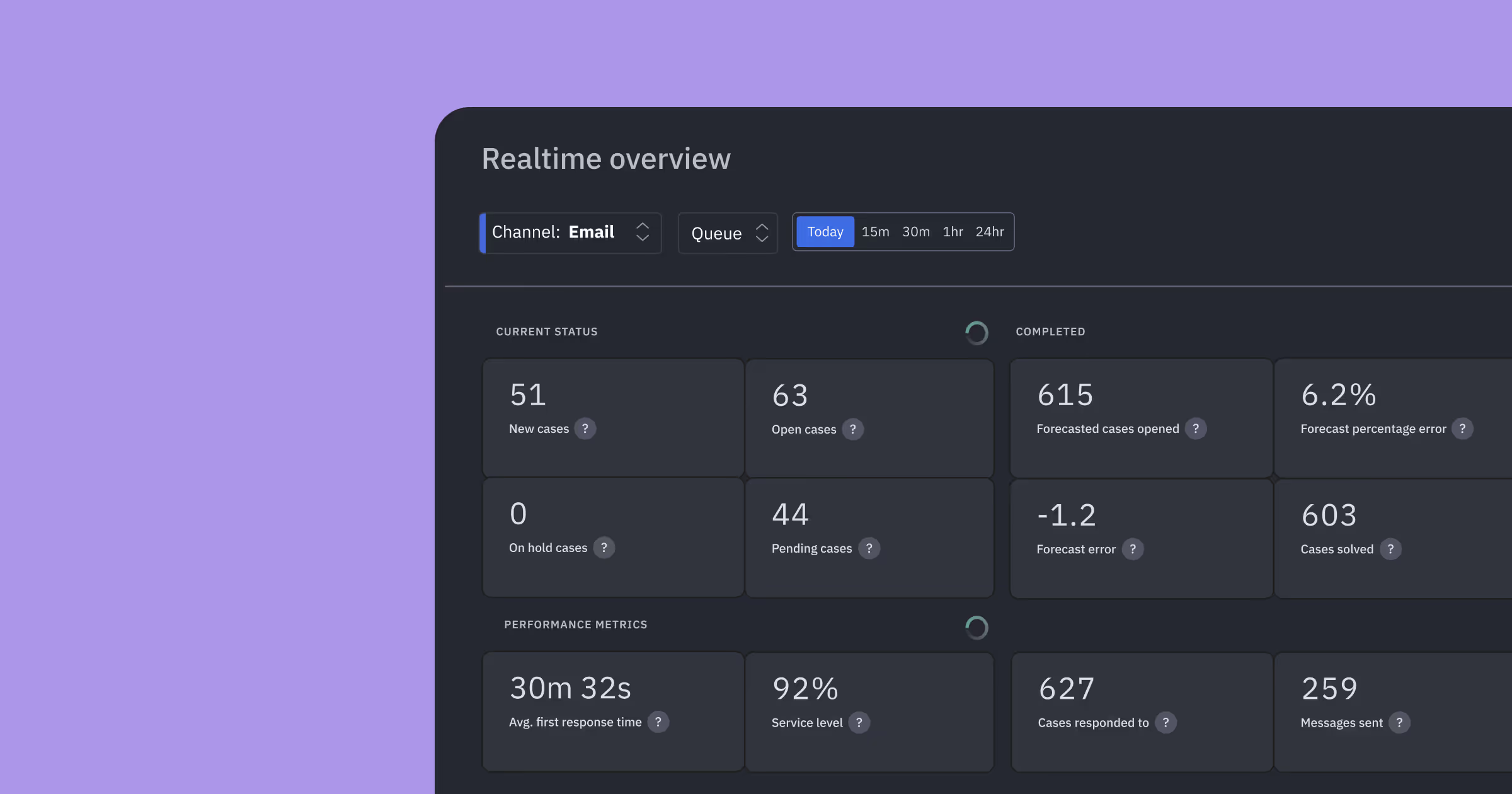Learn about KPIs to measure BPO success
See demo
BPO vendors promise to cut costs and boost efficiency. But choosing the right one is risky. You can’t afford to deliver anything less than exceptional service, as today’s customers expect more from the companies they support. So how do you know that the vendor you choose will bring you the results you need?
While you can’t always tell how a BPO will perform off the bat, you get to set operating standards on the outset. Instituting and monitoring clear goals over time keeps everyone on the same page, ensuring a consistent level of performance.
In this post, we’ll talk about how setting the right goals and tracking the right KPIs for BPOs can generate the time and cost savings you need.
Cost efficiency of BPO
Many companies transition to a BPO because of anticipated cost and time savings. BPOs have cost savings built into their model: workers can be remote and outsourced agents cost less than hiring a full staff. Plus, with additional reps making and answering calls, your company employees can invest their time into more strategic activities, like answering customer queries.
There are several KPIs that monitor the effectiveness of BPO cost-saving measures, including:
- Cost per call: Just like it sounds, cost per call is the average cost of an average call. Understanding cost per call can help customer support leaders manage and forecast their budgets.
- Occupancy: Occupancy rate refers to the length of time agents are occupied, which means that agents are currently on a call or finishing up work from a call. A high occupancy rate implies that agents have plenty of tasks to keep them engaged. A low occupancy rate, on the other hand, suggests that there are too many agents assigned to your work.
Keeping a close eye on these metrics can help you save time and money, one of the main benefits of using a BPO. However, there are several other KPIs you should set to track agent performance to get the most bang for your buck.
Set measurable and realistic goals
To maintain a productive, effective BPO, you need to develop and monitor agents’ quality of performance and speed of execution. Your goals and KPIs should be realistic, but also need to span the BPO’s entire breadth of work. Remember: BPO agents are often assigned tasks related to multiple business areas. This means that the onus is on you to track multiple KPIs simultaneously. Some KPIs you can use to track performance and identify opportunities for improvement are:
- Average speed of answer: Customers want an answer ASAP. Average speed of answer shows how long the average customer is kept waiting before they talk to an agent. Ideally, this number is low, so closely following this metric is key to customer retention and satisfaction.
- Response time: Customers also want their problems resolved quickly. Response time measures the average length of calls, a leading indicator of how long it takes for customers’ problems to be fixed. But customers may bring up complex issues that require nuanced answers, so some successful calls may be longer. That’s why it’s important to examine response time in tandem with other KPIs.
- Call abandonment rate: Impatient callers might hang up before reaching a representative. They could receive another call while they’re waiting to talk to an agent, or the wait time could extend longer than the caller anticipated. Call abandonment rate refers to the number of abandoned calls during a given amount of time. Preferably, your call abandonment rate is low. However, there are a number of variables that could affect this KPI. It’s important to assess this KPI in conjunction with other metrics to paint a more holistic picture of how BPO agents are performing.
- Service level: Service level is the percentage of calls answered in a specific span of time. Typically, service level is used as a signal of agent productivity: The more calls answered in a given time, the more efficient a BPO team is.
This list is by no means exhaustive; there are many other targets you could set for your BPO. But to have a high-functioning BPO, your KPIs must be both measurable and achievable.
Be sure to let your BPO agents know they are being monitored for their performance with metrics. That way, agents can continue hitting their goals, even if issues arise. KPIs can also serve as a motivating factor, pushing reps to better their performance over time.
Improve BPO agent performance
Quality and speed are two necessary ingredients for high BPO performance. Review these metrics early and often to reveal which agents are falling short of their targets: They might need some extra help. With appropriate guidance, these reps can improve their performance. Of course, maintaining a regular touch with BPO leaders can accelerate this process.
It’s important to note that KPIs won’t be in tip-top shape overnight. In fact, it usually takes two to four weeks to get an accurate read on a newly implemented KPI. And you can’t give struggling agents a small window to show improvement, otherwise you could see high turnover rates.
Establish an open line of communication with your BPO vendor. They are the experts, so ask them for feedback and suggestions. Build out a strategy and performance management processes together to ensure that you’re moving in the right direction.
Automation and scalability
It’s impossible to know where your BPO stands without real-time data and analysis. AI-driven tools and automation can make the best agents available for high-value engagements and provide actionable insights. Automation also means dramatically reduced costs. Redundant tasks can be automated, which allows for BPO agents to focus on providing an excellent customer service experience.
The best software is also scalable; it can adjust to the ins and outs of your business as it grows. With one of these platforms, you’ll gain more precise metrics over time, helping you propel your BPO forward.
Optimize your BPO metrics
Predicting how a BPO will perform is tough. But the good news is that when you hire a BPO vendor, you get to set the rules of engagement. By picking KPIs that matter most to your business, keeping a close eye on them, and creating a strong partnership with your BPO vendor, you lay the foundation for a successful, resourceful, and productive call center. Ultimately, measuring KPIs ensures BPOs deliver on their promise of saving you time and money.
But to do that effectively, you need the right tools. Assembled has built-in reporting and forecasting, helping some of the biggest brands manage their BPOs. Real-time insights coach agents to be their best and give you the insights you need to increase service levels and decrease speed of answer and response times. See how Assembled can help your team track and optimize the metrics that matter for your call center today.





